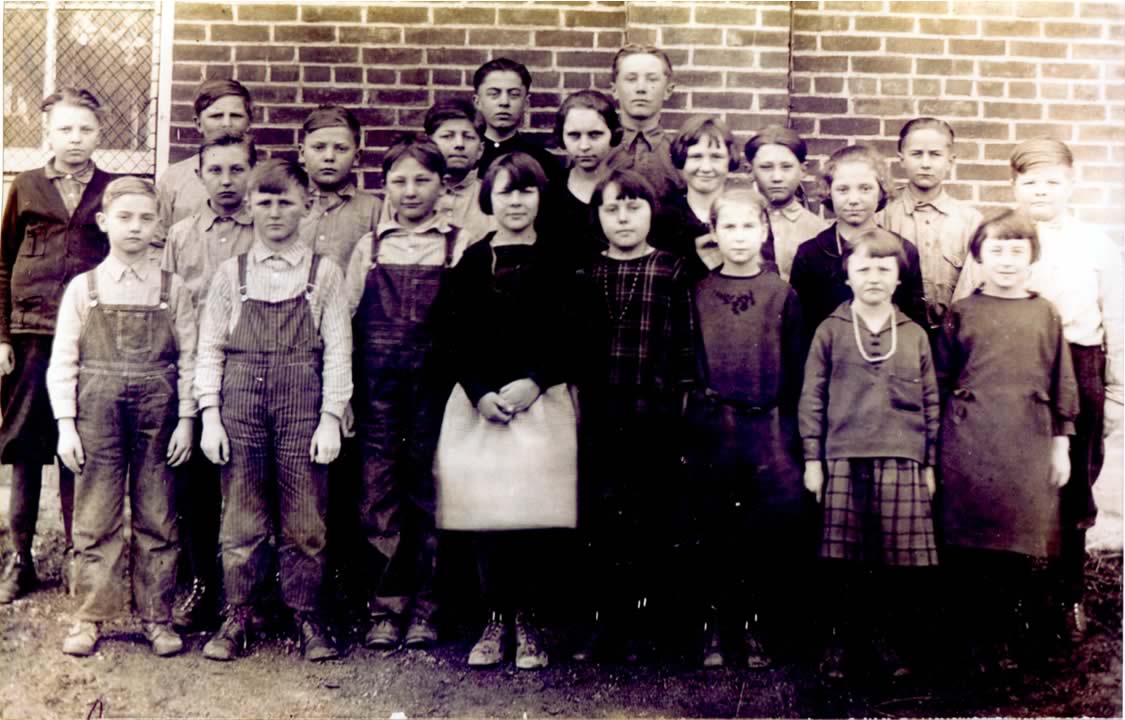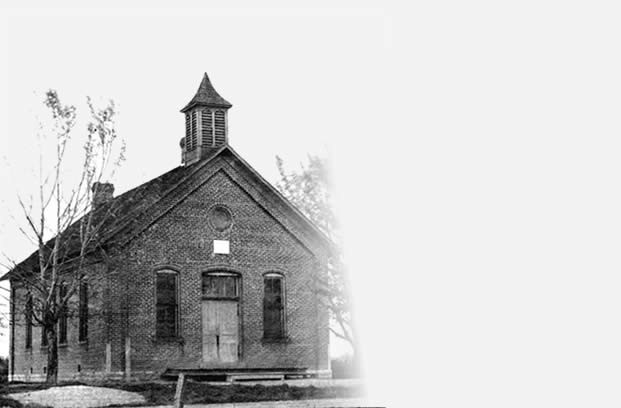by Ruth Settlage Bambauer
I went to a little, red brick, one-room school in the country. I lived on the farm with my parents (William and Ida Settlage) where Adrian and his wife Martha now live. (Both are deceased since this writing).
I had a brother Rufus when I started to first grade. He was three years older than I. We would walk through the fields most of the time because it was a little shorter distance, about a mile in length. We often met some of the neighbor children and walked together.
We carried our lunch in a little tin bucket. We usually had a sandwich—often summer sausage, a cookie and an apple.
In winter we wore long underwear, heavy coats, scarves and spats or boots. Many times Mom would rub my hands and face to warm me after walking home in a cold, westerly wind.
Our teacher would allow us to put an apple on a stick and prop it up near the red hot bowl of the coal furnace that heated the room until it was baked. On real cold days we were allowed to sit two in a seat near the furnace. The boys were in charge of carrying in the coal from the coal shed.
Our teacher was a janitor and playground instructor as well. She would play tom ball, anti over the schoolhouse, hide and seek, drop the handkerchief, etc.
We had outdoor toilets and a hand pump for our drinking water. We all drank from the same tin cup.
In the morning our teacher read a Bible story, and before dismissal we sang the first verse of the hymn, “Day Is Dying in the West.”
There were eight grades if there were pupils to start each year. Vernon Deerhake and I were in the same class for years until Wilma Opperman failed, and then we had three in our class.
I could hardly talk English since we talked mainly Low German at home. My first day at school, I remember the older children all looking at me, and someone said, “Heck, she can’t even talk English.” Sometimes I told my teacher I didn’t know the answer to her question in English. She would then allow me to say it in German.
Our music teacher came once a week. Mr. Gephart was a dear old man. He would sometimes sing to us.
Our school had a bell, which the teacher rang when classes would begin. Across the front of the room was the blackboard. We often had to work our arithmetic and practice our writing on it. We had a huge dictionary on a desk to the back part of the room where we could go to look for the meaning of a word or how to spell it.
There was a girl’s and a boy’s cloak room where we hung our coats and sweaters. Also we had a washstand with a pail of water, granite basin and towel in case we needed to wash our hands. We got a scolding if we left the soap in the water.
Some of the events were box socials, held in the evening. Young girls would pack a lunch in a beautiful, decorated box. These would be sold to the highest bidder, and whoever bought the box would get to eat with the girl who packed it. Of course, if it was someone’s girlfriend, the other boys would bid against him. The girl would secretly tell her friend how she had decorated it. Usually it was covered with crepe paper.
Our school (Cloverleaf) raised enough money ($90) to buy a piano. Before this our music was a Victrola.
The last day of school was a big event. The family came with a carry-in dinner, a real social gathering. This was the last part of April. The farmers needed the children to help with the planting of garden and crops.
The year I graduated from the eighth grade (1929) was the last year for the school. It was torn down, and the brick was used by LeRoy Deerhake to form the basement walls under his home in New Knoxville. That year my teacher, Mary Rodeheffer, and my mother planned a birthday party for me (May 5). That was a big surprise. I had never thought anyone would ever have a party for me.
Cloverleaf School - 1923

Front Row: Calvin Elshoff, Vernon Deerhake, Frederick Kuck, Gertrude Schmidt, Luella Opperman, Ruth Schroer, Mildred Deerhake, Rachel Thielk.
Second Row: Leonard Meckstroth, Wilmer Opperman, Rufus Settlage, Miss Arminta Kuhlman (teacher), Edna Deerhake, Harry Wierwille, Evelyn Schroeder, Carl Schroer, Willis Katterheinrich. Back Row: Harold Opperman, Alfred Katterheinrich, Harold Thielk, Arnold Wierwille.
When I started to high school, we had to find our own way (no bus). By this time my brother Rufus could drive a car. My father had just bought a new Model A Ford, and we were so proud to drive it to school at New Knoxville.
There was a lot of difference between the town kids and the farm kids. The town kids laughed at us when we wore heavy stockings, and our parents learned that we would not wear long underwear to high school. We had no cafeteria, so farm kids ate a packed lunch, and two kids went home.
We had high school parties about once or twice a year, but I wasn’t allowed to go to many of them. Too far at night. Also, there was a basketball game, but we hardly ever got to go, and, of course, could not play on the team.
Our studies were English, Latin, algebra, geometry, science, history, home economics and music. We had gym classes and wore uniforms: a white middy blouse with black tie and black satin, pleated bloomers (below knee). We had four teachers plus a music teacher.
The juniors and seniors had a prom near the end of the year. It was a movie and after that, a dance. Dancing was frowned upon by many, and some were not allowed to go. I never did learn how to dance. I was a wallflower.
Initiation parties were the upperclassmen playing tricks on the freshmen or making them do odd things like crawling on hands and knees and getting a whack on the behind.
I lived through it all and graduated in 1933 even though I didn’t get a class ring. The banks were closed at the time, and the Depression was on. I could not ask my parents for a ring when I knew they could hardly scrape up enough money for the farm payments.
NOTE: Ruth Bambauer’s home place was the Settlage farm located at 11780 State Route 29, where her brother Adrian lived his entire life, and where he and his wife Martha Maneke Settlage raised their family.
NOTE: The Cloverleaf School was located two miles north of New Knoxville on the north side of Cloverleaf Road and west of Glynwood-New Knoxville Road.
NOTE: The teacher in the picture, Miss Arminta Kuhlman, later became Mrs. Arminta Grimes, and after the passing of her husband she remarried and became Mrs. Thieman. She finished her teaching career teaching second grade in the New Knoxville school.


